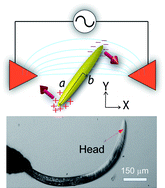Dielectrophoresis of Caenorhabditis elegans†
Abstract
We demonstrate for the first time the dielectrophoretic trapping and manipulation of a whole animal, the nematode Caenorhabditis elegans. We studied the effect of the electric field on the nematode as a function of field intensity and frequency. We identified a range of electric field intensities and frequencies that trap worms without apparent adverse effect on their viability. Worms tethered by


 Please wait while we load your content...
Please wait while we load your content...